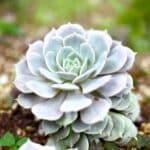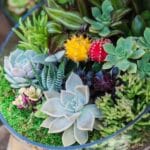Monsteras deliciosa (split leaf philodendron) is a unique, easy-to-care-for houseplant whose leaves are beautified with hole formations. It’s a vining plant and love to climb along a stake or trellis or trail over the pot.
Monsteras generally love bright, indirect sunlight, but also survives under fluorescent lights. This amazing plant tolerant the occasional missed watering, making it suitable for inexperienced plant growers.
Monstera deliciosa is also known for its distinctive leaf patterns – and in this post, we talked about how to grow and care for monstera deliciosa to ensure a healthy and beautiful plant.
Table of Contents
What is Monstera Deliciosa? | Monstera Deliciosa Origin
| Common Names | Split leaf philodendron, windowleaf, Swiss cheese plant, ceriman |
| Botanical Name | Monstera deliciosa |
| Native | Central America |
| Family | Araceae |
| Soil Type | Peat-based potting soil, well-drained |
| Plant Type | Climbing evergreen |
| Mature Size | 3 ft. tall, 2-3 ft. spread |
| Soil pH | Acid or neutral |
| Sun Exposure | Bright indirect sunlight, partial shade |
| Flower Color | Cream/tan |
| Bloom Time | Mid-summer |
| Toxicity | Toxic to cats and dogs |
| Hardiness Zones | 10-12 (USDA) |
Also known as split leaf philodendron, monstera Deliciosa originated from the rainforests of Central America – and is a popular houseplant that is loved by many.
It is a beautiful climbing evergreen indoor plant. Most interior designers favorite it for residential and commercial spaces, especially as it's an easy-to-grow houseplant.
When grown indoors, the plant has a moderate growth rate and can grow in height about 1 to 2 feet annually. It has leathery, glossy, characteristic split, and heart-shaped leaves from intricate aerial roots that can be used for ropes and basket-making.
Due to its perforated leaves that can grow to 3 feet long, it is known as the Swiss-cheese plant.
Planting the Monstera Deliciosa outdoors in the right zone at any time during the year will produce tannish-cream flowers pollinated by bees and edible juicy fruit with the combined flavor of pineapple and banana.
Monstera Deliciosa Care & Growing Tips
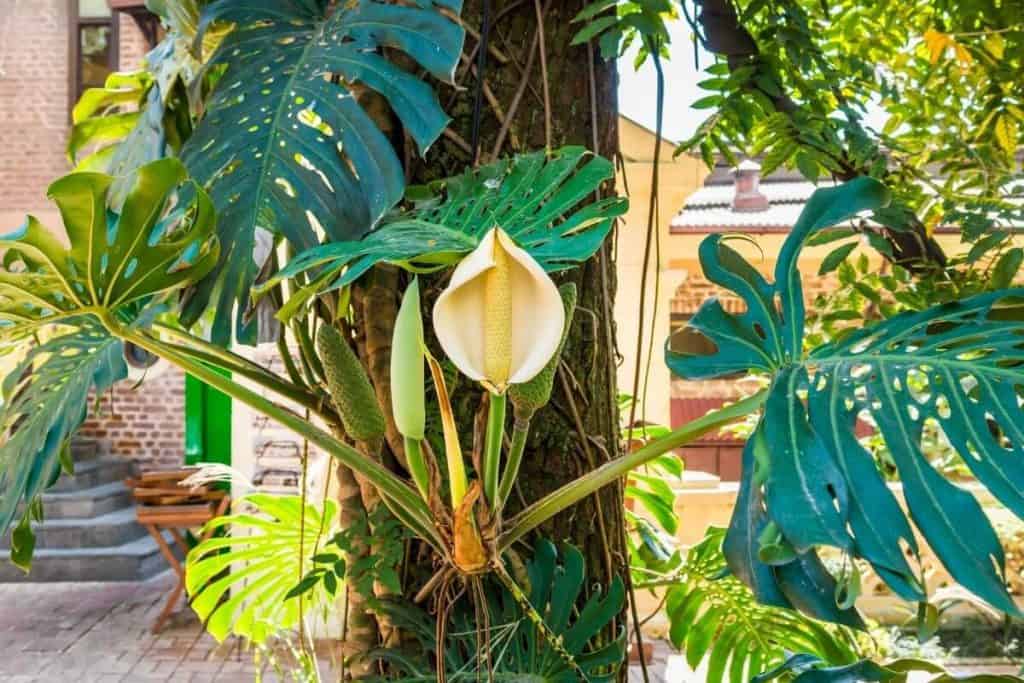
Below is everything you need to know about monstera deliciosa care and how to grow into a healthy and happy plant.
Natural Habitat
Hardy in USDA Zones 10 through 12, the Monstera deliciosa thrive year-round in warm, humid weather. Therefore, if you plan to plant them outdoors, ensure they are kept in part-shade in well-draining soil.
If the soil in your region is naturally salty, move it to the patio or indoors, as it won't go down well with your plant.
You can aid its growth by applying a balanced fertilizer three to four times annually, as it will help the plant grow up to 10 feet tall or more.
Are you planning on growing them indoors? No problem, choose a deep pot with many drainage holes and make sure you give them a favorable condition they will require, closer to the one they thrive on when grown outdoors.
Light Requirements
Growing the best healthy Monstera Deliciosa as possible demands you to mimic the natural tropical habitat they are used to. You can do this by simply keeping them in filtered, indirect sunlight that can help them to grow well.
In other words, you should always try to prevent them from receiving strong direct light because it can make the plant develop scorched or yellow leaves.
You should also note that they are used to the dappled light of the rainforest floor; hence, the more direct light it receives, the more the plant's foliage suffers.
With the perfect temperature of the plant required at around 70°F and a little humidity added to that, you should be sure that they can grow better and feel at home.
Meanwhile, when you discover any part of the plant reaching for the sunlight, you have to rotate it to ensure even growth on all sides.
The perfect spot for your plant could be near your bathroom or kitchen window, where they can receive indirect light and adequate humidity. Or if you'd rather place it somewhere else, you can choose to mist it now and then.
If your plant is not getting enough light, you may begin to discover a leggy growth on it; therefore, you should place it at a spot a few feet away from an eastern, western, or southern-facing window that will do the trick.
Watering Requirements
Monsteras are tropical plants, which means they like to be planted in moist soil. Therefore, as long as watering is concerned, you need to water your Monstera Deliciosa once the soil is dry at the top of the pot.
You can check this through the use of a moisture meter or your finger. If you notice the top 5 cm (2 inches) is dry, then your plant needs watering. Make sure the soil does not excessively dry out, as it will cause its leaves to begin to sag.
Immediately you discover the leaves drooping; you need to water the plant as soon as possible because your plant is at risk of drying out.
Another sign that your plant is beginning to dry out is once you have noticed brown and crispy edges on the leaves. If you water the Monstera excessively or too regularly, it will be revealed by the plant.
If you overwater the Monstera, it will cause its leaves to turn yellow. When you allow the plant to reveal what it wants, you won't find any difficulty helping them grow healthy, as the plant will always show you when something is wrong, thus, making it perfect for new plant owners.
Again, once you notice that the tips of your Monstera leaves are turning brown, yellow, or black, it indicates that it's excessively watered.
The best thing to do at this point is to stop any watering, drain the excess water out of the soil and let the soil dry out before re-watering.
Also, once you discover that your plant has developed root rot, the best thing to do at this point is to repot the plant and plant it in some new (dry) soil.
A rule of thumb to use when watering states that: Only water your plant when the top 5-7cm (2-3 inches) is dry. Failure to abide by this, you are risking overwatering your plant.
Humidity & Temperature
Humidity-wise, the perfect condition for your Monstera Deliciosa is the normal room humidity, but it prefers to be in humid conditions if possible.
If your room lacks the adequate humid conditions your plant requires, you can consider supplementing it using a fine-mist mister or humidifier to boost humidity level indoors.
Temperature-wise, much like some other Monstera varieties or houseplants in general, the Monstera Deliciosa houseplants thrives in temperatures that range between 65°F to 85°F (18°C to 30°C). The best thing is never to allow it to go below 60°F (15°C).
Monstera Deliciosa Soil Requirements
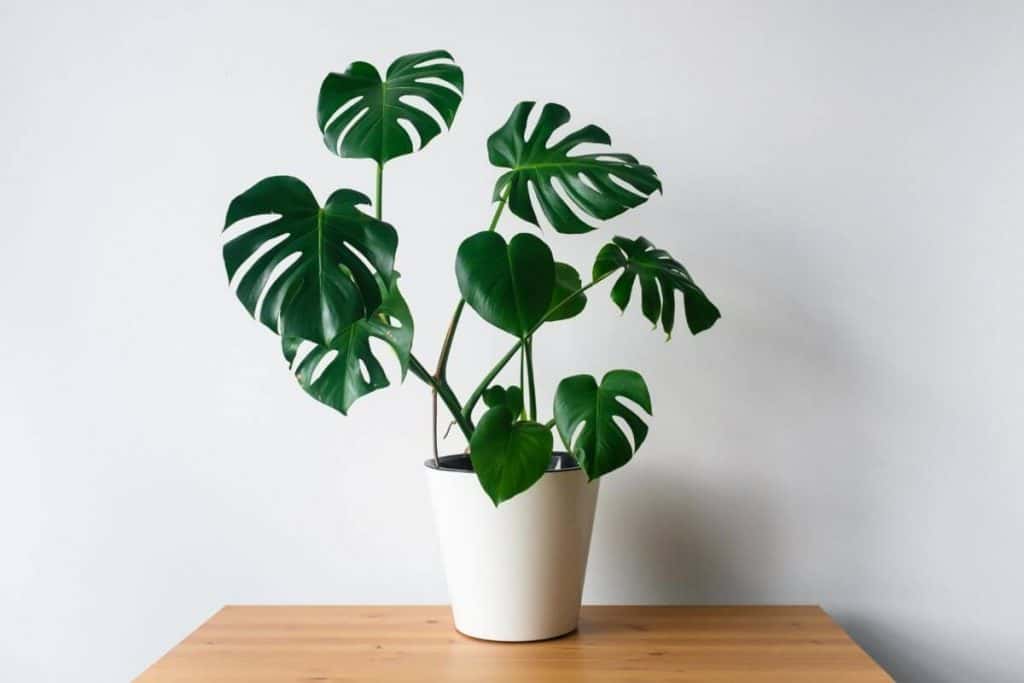
Like other Monstera varieties, the Monstera Deliciosa generally thrives in potting mix that retains moisture and drains well.
They prefer a soil mix that contains a little acidic pH, ranging from 5.5 to 6.5. The ideal soil mix is 1 part peat moss/coco coir, 1 part perlite, and four parts pine bark fines.
For you to choose a soil mix means you want it to provide your plants with five things, including a place to anchor, proper gas exchange, the right amount of water, temperature control, and nutrients.
Therefore, if you select a potting mix that doesn't suit your plant, it will cause your plant to struggle to obtain what it requires and can cause serious issues and even death.
If you're using the wrong soil mix, it will be revealed to you by your Monstera. Yellow or Yellowing Monstera leaves is one of the common signs that something is wrong with the mix you're using.
When you notice this sign, it means that your plant isn't getting enough air or water.
If the mix you're using doesn't provide adequate drainage, your plant will be sitting in water. In simple terms, it's drowning. Also, if you are using a mix that doesn't retain enough water, your plants may not take in the water they need, resulting in yellow leaves.
Another symptom of improper soil mix is brown spots which resulted from root rot caused by excessive watering. These spots may look small and then enlarge and spread across every part of the plant over time.
You might keep to the required watering conditions, that is, once every few weeks, yet, a wrong soil mix can prevent soil from drying out. As the roots dwell in steady moisture, they start to rot, and your plant cannot properly receive water or nutrients.
Generally, all Monstera plants, including the Deliciosa, grow best in soils that contain slight acidic pH. Note that a neutral pH is 7.0, and any number below this is considered acidic.
In other words, the perfect soil mix for all Monstera varieties is a pH that ranges from 5.5 to 6.5.
Monstera Deliciosa Fertilization
As it is with other Monstera varieties and indoor plants, fertilizing is important for the Monstera Deliciosa. Yet, the problem is that most people tend to overfeed them, believing it is best for growth. That notion is wrong, as over-fertilizing Monstera can cause problems.
Therefore, we recommend you use a balanced liquid 20-20-20 fertilizer every few weeks during the growing season for the Monstera.
Dilute ½ teaspoon of the fertilizer in a gallon of water. Ensure you use the diluted fertilizer in place of constant watering.
Pour the mixture into the soil until it starts pouring out of the drainage holes. Then, eradicate the excess diluted fertilizer, as the plant has consumed what it needs to its satisfaction and cannot use the extra that it drains off.
Planting (Potting & Repotting) of Monstera Deliciosa
For larger floor plants like the Monstera Deliicosa, we recommend you report every 18 to 24 months. Typically, you want to choose a potting container 2 to 4 inches bigger in diameter to accommodate the plant's maturity stage.
Avoid using a pot that is much larger than the initial one because it could end up drowning the plant's root.
If you want your plant to retain its original size, you can report in the same container and provide new soil for it and trim away some roots and foliage. The ideal potting season is during the spring or summer, as the plant is at its strongest.
How to Prune Monstera Deliciosa
You can prune the aerial roots of your Monstera Deliciosa if they become too unruly for the space; however, tucking them back into the pot is preferred.
Contrary to most other houseplants, their roots do not damage surfaces. Their stems and leaves allow for trimming and can be used for propagation.
How to Propagate Monstera Deliciosa
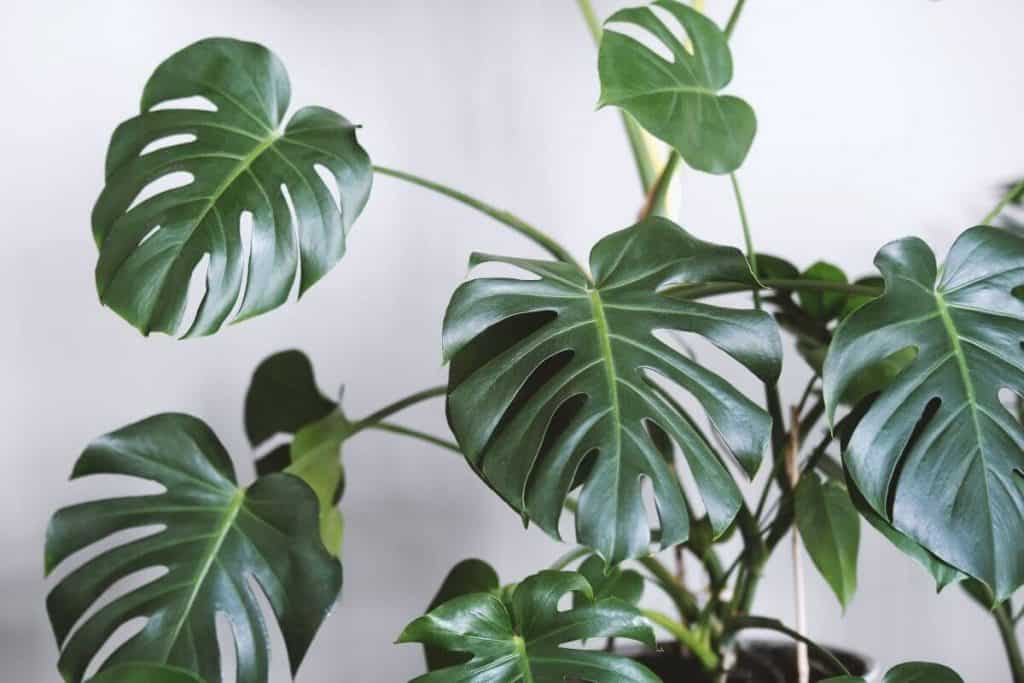
The Monstera deliciosa can easily be propagated by using the leaf bud cuttings method.
Another propagation method, especially for an older, taller specimen that's lost its lower leaves, is through the air layering method, by air layering the top portion of your overgrown plant before pruning back its overgrowth.
Propagation by Leaf Bud Cuttings
- Provide a container big enough to accommodate three or four cuttings with fresh all-purpose potting soil.
- Using a clean, sharp blade, cut a segment of healthy Monstera stems from the mother plant. Pick a portion of the stem that has several leaves.
- Cut that stem into several segments, with one leaf per segment. Segments may also have an aerial root attached.
- You can plant three or four of the stem segments in the same pot, as it will create a bushy, full look in the new container.
- You can also propagate the stem segments in water for a few weeks before planting. New growth will emerge from the point where the leaf and stem meet.
Propagation by Air Layering Method
This method of propagating Monstera augurs particularly well to jump-start a leggy, overgrown specimen that's lost its bottom leaves while producing a new plant.
To propagate your Monstera Deliciosa with this method, you will require a sharp knife or other cutting tools, a toothpick, a handful of long-fibered sphagnum moss, twine or strong string, a sheet of clear plastic (like a plastic sandwich bag or a piece of plastic cling wrap), and optional rooting hormone, then proceed with the following steps;
- Examine your Monstera's leggy stem to identify the spot where you'd like the roots of your new plant to grow. Choose a spot that's at least six inches below the bottom of where leaf growth begins.
- Using a clean, sharp blade, carefully make an upward diagonal cut about one-third of the way through the stem at the point you chose.
- Insert a toothpick sideways into the cut to keep it open through the rooting process. To speed the process, you can apply rooting hormone to the freshly cut surface of the stem at this point, but new roots will still grow without it.
- Moisten a big handful of the sphagnum moss and tie it around the cut on the stem using the twine. This will give the new roots a medium to grow into.
- Tie the sheet of plastic around the ball of sphagnum moss so that it will hold the moisture in.
- Care for your Monstera as usual. You should see new roots growing through the moss within a few months.
- When you see new roots, remove the plastic wrap and cut through the stem below the new growth. Plant your fresh Monstera, leaving the moss on the roots, in an appropriately-sized pot with fresh all-purpose potting soil, and then care for it as usual.
- After removing the air layer, cut the mother plant back significantly. New growth will appear just below this cut.
Frequently Asked Questions
How much light does a Monstera Deliciosa need?
Monstera deliciosa needs medium to bright indirect light to thrive. It also tolerates lower light conditions, but it may lead to leggy growth.
How do you know if your Monstera is happy?
A happy Monstera plant usually has deep green, waxy leaves. Younger monstera plants or new leaves may be lighter green though.
Should I mist my Monstera deliciosa?
Yes, you should frequently mist monstera deliciosa leaves because it enjoys a humid environment. Alternatively, you can keep it close to other plants, to increase the humidity of the air around the plant.
How often should I water Monstera Deliciosa?
Monstera deliciosa needs moderate and evenly watering – and it should be watered about once per week. Then wait until the soil is somewhat dry before watering the plant again.
How do I curb the growth of monstera deliciosa?
To curb excessive growth of monstera deliciosa, avoid re-potting the plant too often and prune it regularly by pinching off new growth.
When should I bring my Monstera inside?
Monstera is hardy in USDA plant hardiness zones 10 through 12 – and it’s usually grown in pots. Therefore, you can take it indoors when the temperatures drop below 50°F in fall.
Can a Monstera Deliciosa live in low light?
Yes, monstera deliciosa tolerates low light and it can grow anywhere in your home. But it grows quicker and becomes more dramatic in places with indirect bright sunlight. Keep it away from strong, direct light as it may burn the leaves.
Why is my Monstera deliciosa not splitting?
Monstera deliciosa may not be producing split leaf due to insufficient sunlight, which is the most common reason for this; however, incorrect fertilization or watering can equally be a contributing factor.
Do Monstera deliciosa like to be root bound?
No, Monstera Adansonii dislikes being root bound! The plant will not grow to its full potential without being able to get the water and nutrients into the soil that it needs.

